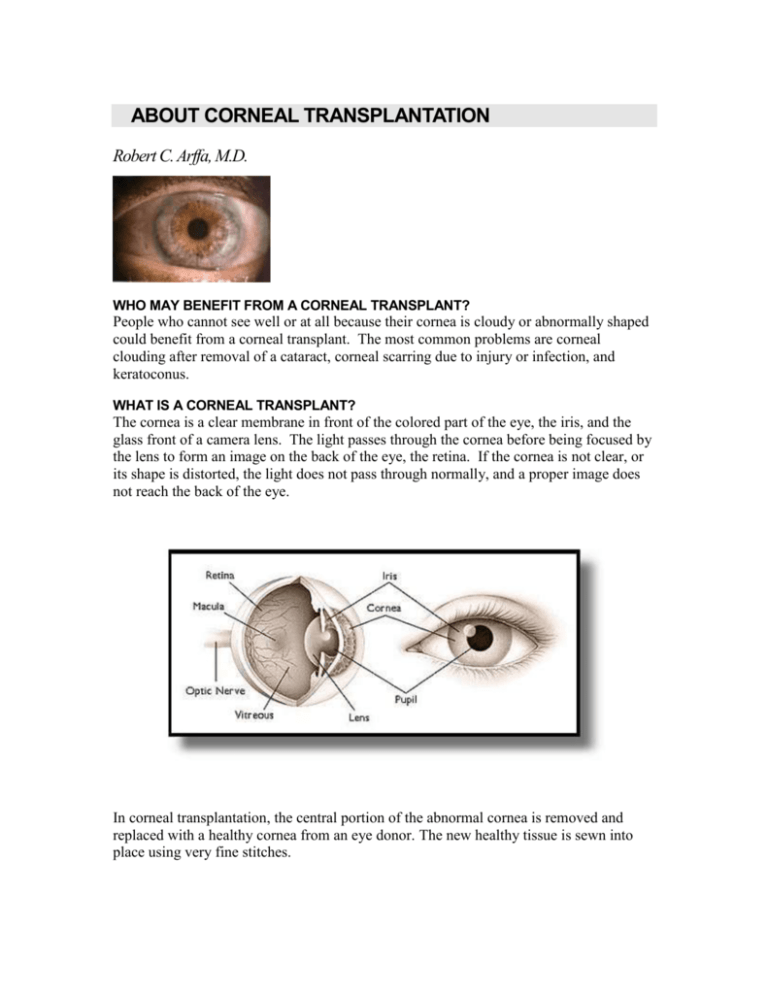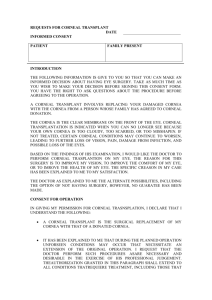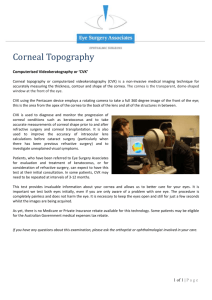ABOUT CORNEAL TRANSPLANTATION
advertisement

ABOUT CORNEAL TRANSPLANTATION Robert C. Arffa, M.D. WHO MAY BENEFIT FROM A CORNEAL TRANSPLANT? People who cannot see well or at all because their cornea is cloudy or abnormally shaped could benefit from a corneal transplant. The most common problems are corneal clouding after removal of a cataract, corneal scarring due to injury or infection, and keratoconus. WHAT IS A CORNEAL TRANSPLANT? The cornea is a clear membrane in front of the colored part of the eye, the iris, and the glass front of a camera lens. The light passes through the cornea before being focused by the lens to form an image on the back of the eye, the retina. If the cornea is not clear, or its shape is distorted, the light does not pass through normally, and a proper image does not reach the back of the eye. In corneal transplantation, the central portion of the abnormal cornea is removed and replaced with a healthy cornea from an eye donor. The new healthy tissue is sewn into place using very fine stitches. The operation is normally performed while you remain awake but sedated. The eye is numbed so that you will not feel or see any of the operation. Depending on our eye, and the exact procedure required, the operation will take approximately 1-2 hours. Most of the time you can go home the day surgery. In other cases, patients stay in the hospital overnight. HOW LONG DOES IT TAKE FOR VISION TO IMPROVE? Some people will see an immediate improvement in their vision after surgery. In most cases the initial vision is the same or worse than before surgery. However, the final result of the surgery will take several months to determine. New glasses or contact lenses will not be given until at least 4-6 months after surgery. Healing will continue to occur for about one year, and sometimes the best vision is not obtained until that time. WHAT IS THE CHANCE OF OBTAINING A CLEAR HEALTHY CORNEA AFTER SURGERY? The odds of success of the operation depend on the type of eye problem for which you are having the surgery. In most cases, the chances are 90% that you will have a clear, healthy cornea after surgery. WHAT HAPPENS IF YOUR CORNEA DOES NOT STAY CLEAR? If the corneal transplant does not remain clear, the surgery can be repeated, replacing the cloudy transplanted cornea with a new cornea. WHAT ARE THE RISKS OF A CORNEAL TRANSPLANT? The risks of a corneal transplant are similar to the risks of cataract surgery, or other surgery in which the eye is opened. Some of the more common or more serious possible complications are as follows: There is a small risk from the anesthesia. Any time that you are put to sleep (general anesthesia), there is a very small risk of complications. There is slightly less risk in numbing the eye while you remain awake, but even this can result in complications. The risk of sight-threatening or life-threatening complications is extremely low. Any time that surgery is performed inside the eye, there is a risk of bleeding or infection developing in the eye. Precautions are taken to prevent this from occurring, and even if such problems develop, in most cases they can be cleared up with treatment. Increased pressure inside the eye may occur after surgery, particularly if you have this problem (glaucoma) before surgery. The pressure usually can be kept under control with eye drops or medicine by mouth, but further surgery may be required in extreme cases. The retina is where the image forms in the back of the eye. The retina converts the light to electrical energy that is transmitted by the optic nerve to the brain. Damage to the retina may occur after any surgery in which the eye is opened. Since the new cornea is from another person’s eye, your body may “reject” the new tissue. In most cases, this reaction can be stopped, particularly if treatment is started promptly. However, rejection is the single most likely complication of corneal transplantation. DONOR CORNEAS Eye donors are screened to eliminate those with diseases that may be transferred to you via the donor cornea. The donor’s general and eye medical history are reviewed, and blood test are performed for hepatitis and AIDS. AIDS has never been transmitted via corneal transplant, but we test for it as a precaution. While none of these tests are infallible, there is only a remote chance of transmitting disease via corneal transplantation. PHYSICAL ACTIVITY AFTER A CORNEAL TRANSPLANT The cornea heals slowly. It takes approximately one year to heal fully. Therefore, you should try to avoid heavy lifting or straining right after surgery. You will be able to swim (using goggles) approximately two weeks after surgery. You can return to work, if it does not require a lot of lifting or straining, as soon as you are comfortable enough, usually approximately one week after surgery. HOW OFTEN WILL YOU NEED TO RETURN FOR EXAMINATIONS? You will be seen every 1-2 weeks for the first month and then approximately monthly until one year after surgery. After this, you will need to be seen every 4-6 months. After the first three months, many of these visits may be performed by your general eye doctor. You do not need to see the surgeon for all these visits.







